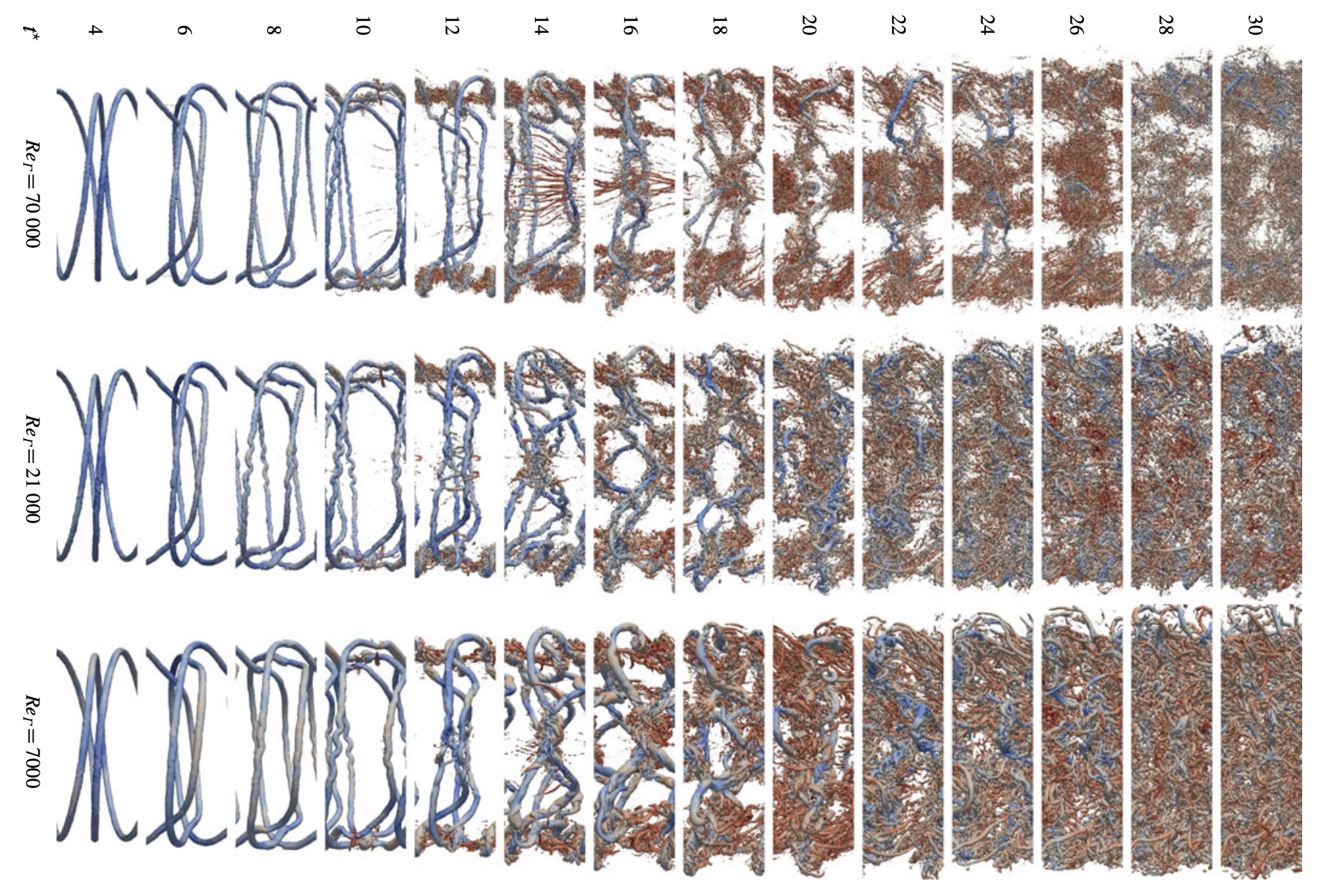Email: zhao596[at]purdue.edu
This paper investigates pre- and post-reconnection dynamics of an unperturbed trefoil knotted vortex for circulation-based Reynolds numbers 2000 and 6000 by means of direct numerical simulations based on an adaptive mesh refinement framework. Companion coherent-vorticity preserving large-eddy simulations are also carried out on a uniform Cartesian grid. The complete vortex structure and flow evolution are simulated, including reconnection and subsequent separation into a smaller and a larger vortex ring, and the resulting helicity dynamics. The self-advection velocity before reconnection is found to scale with inviscid parameters. The reconnection process, however, occurs earlier (and more rapidly) in the higher Reynolds number case due to higher induced velocities associated with a thinner vortex core. The vortex propagation velocities after reconnection and separation are also affected by viscous effects, more prominently for the smaller vortex ring; the larger one is shown to carry the bulk of the helicity and enstrophy after reconnection. The domain integrated, or total helicity, H(t), , does not significantly change up until reconnection, at which point it varies abruptly due to the rapid dissipation of helicity caused by super-helicity hotspots localized at the reconnection sites. The total helicity dissipation rate predicted by the large-eddy simulation agrees reasonably well with the direct numerical simulation results, with a significant contribution from the modelled subgrid-scale stresses. On the other hand, variations in the vortex centreline helicity, HC(t), and the vortex-tube-integrated helicitym HV(t), are less sensitive to the reconnection process. Periodic vortex bursting events are also observed and are shown to be due to converging axial flow velocities in the detached vortex rings at later stages of evolution.
- Xinran Zhao and Carlo Scalo, Helicity dynamics in reconnection events of topologically complex vortex flows Journal of Fluid Mechanics, 2021, Vol 920, A30 [PDF] [DOI] [BIB]
- Xinran Zhao, Zongxin Yu, Jean-Baptiste Chapelier and Carlo Scalo, Direct-Numerical and Large-Eddy Simulation of Trefoil Knotted Vortices Journal of Fluid Mechanics, 2021, Vol 910, A31 [PDF] [DOI] [BIB]
Email: jchapeli[at]purdue.edu
This project is focused on the development of state-of-the-art subgrid-scale modeling for an accurate descrtipion of transitional, wall-bounded and high-Reynolds number turbulence. A new approach termed Coherent-vorticity preserving LES (CvP) has been developed and aims at injecting subgrid dissipation only in regions where under-resolved, fully developed turbulence is present. The approach is based on the scale separation of the enstrophy field using test-filtering in order to separate regions dominated by coherent vortices from broadband turbulence. The resulting turbulence sensor function can be coupled to any subgrid model and lowers effectively the intensity of subgrid stresses in the vicinity of coherent vortices. The method is applied to various high-Reynolds number flows relevant to rotor-wake dynamics, such as the bursting process occuring in knotted vortices, the mutual induction of arrays of helical vortices and turbulent-turbulent wake dynamics.
- Jean-Baptiste Chapelier, Bono Wasistho and Carlo Scalo, Large-Eddy Simulation of temporally developing double helical vortices, Journal of Fluid Mechanics, 2019, Vol. 863, pp. 79-113. [PDF] [DOI] [BIB]
- Jean-Baptiste Chapelier, Bono Wasistho and Carlo Scalo, A Coherent-vorticity preserving (CvP) eddy viscosity correction for Large-Eddy Simulation, Journal of Computational Physics, 2018, Vol. 359, pp. 164 - 182 [PDF] [DOI] [BIB]
